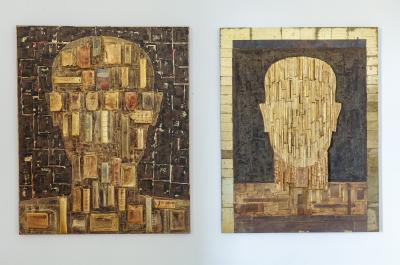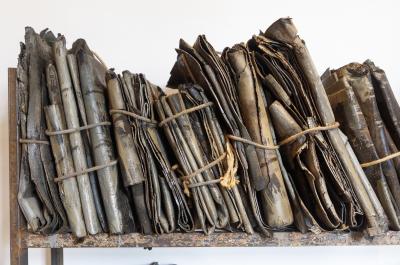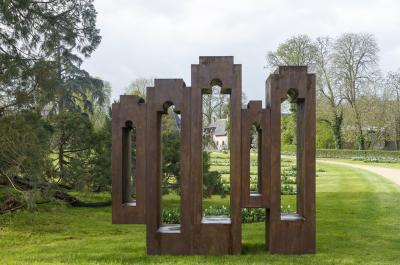A. Stefan Râmniceanu
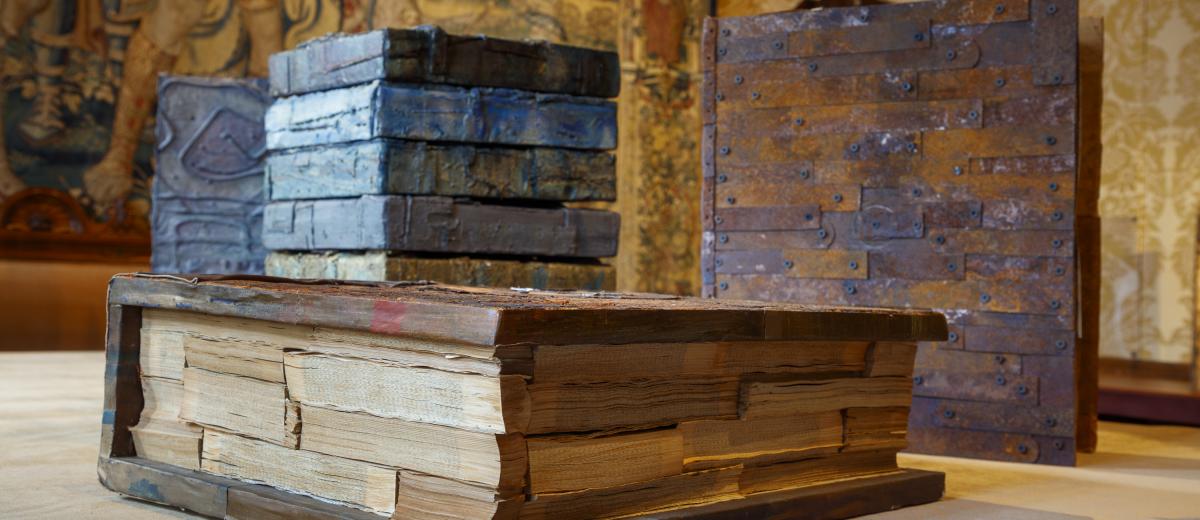
It would be difficult to associate Stefan Râmniceanu’s work with any movement in particular, although his attachment to the Romanian Byzantine tradition is well known. “A concentrate of diverse sensations and experiences, his painting is a subtle dose of dogma and dream, where forms and emotions are in close correspondence with each other, constituting a vibrant cosmic poem,” asserted Arlette Sérullaz, Honorary General Curator at the Louvre’s Graphic Arts Department, in 2001. The language of matter is at the heart of Râmniceanu’s visual research, while most of his works have a three-dimensional structure. The accumulation of strata, with penetrating variations of colour, gives his paintings an almost sculptural relief structure. “Perspective doesn’t interest me much, I make my way into the depth of the matter, its more what’s hidden in it that calls to me. As I spend much of my time in my inner world, through the chimera of painting, I try to express all my anxieties, despairs and terrors,” the artist explains.
At a time when provocation often becomes the basis of a creative system, Stefan Râmniceanu sides with spirituality in art. He defines this search as an initiatory path to the figure / archetype of a “universal man”, a contemporary resurgence of the Renaissance man. If we take a closer look, his creative energy is somewhat reminiscent of Albert Camus’ maxim “Blasphemy is reverent since every blasphemy is, ultimately, a participation in holiness”, seeing how much the desire for rupture that imbues Râmniceanu’s creation is enriched by the pictorial traditions of bygone centuries. “I don’t paint with tubes of paint or with brushes, I paint with the memory of things”, he states.
Over the course of the last forty years, his work has developed through a process of accumulation and intercrossing of themes, motifs and symbols, which are revisited and overlapped repeatedly in a variety of media. Highly symbolic connections emerge from metal, concrete, wire and other heterogeneous materials. Numerous layers of muted colours provide the surface of his paintings with a relief structure, an almost sculptural plasticity. As a result, a vocabulary is constructed at the crossroads of a variety of disciplines (painting, photography and sculpture), which the artist is still seeking to develop further. Now recognised as forming an integral part of his body of work, his sculptures have gradually become more and more monumental, a trend illustrated, for example, by Le Bâtisseur (The Builder), an 8-metre-high piece created in 2014 and presented the same year at the Mogosoaia Palace in Bucharest during the Marks retrospective, an event that marked the artist’s triumphant return to his native Romania, which he had left in 1991 to settle in France.
On the occasion of the exhibition, the historian Răzvan Theodorescu wrote, “Stefan Râmniceanu, the artist who started out by painting landscapes with an introspection worthy of some of Andreescu’s canvases, once again testifies to the fact that he belongs to this culture through the deep, monumental contemplation of his morphologies, his genial chromatic harmonies, his imagery, which has come down from all those who, in this part of the world, came to believe in the splendid heresy according to which a piece of wood bearing an image – an ‘eikona’ – could be revered, and that, beholding it, man could surpass his own limits in what, quite literally, the ancients called ‘ekstasis’. Our century, which focuses more on symbols, eschatologies and the universal, embraces the spiritualties of the past, through the great artists of the East, and above all through revolutions, since Kandinsky, Tatlin and Malevitch. As to the recurrences of such spiritualties, they too may be arguments for duration, silence and waiting.”
BIOGRAPHICAL NOTES
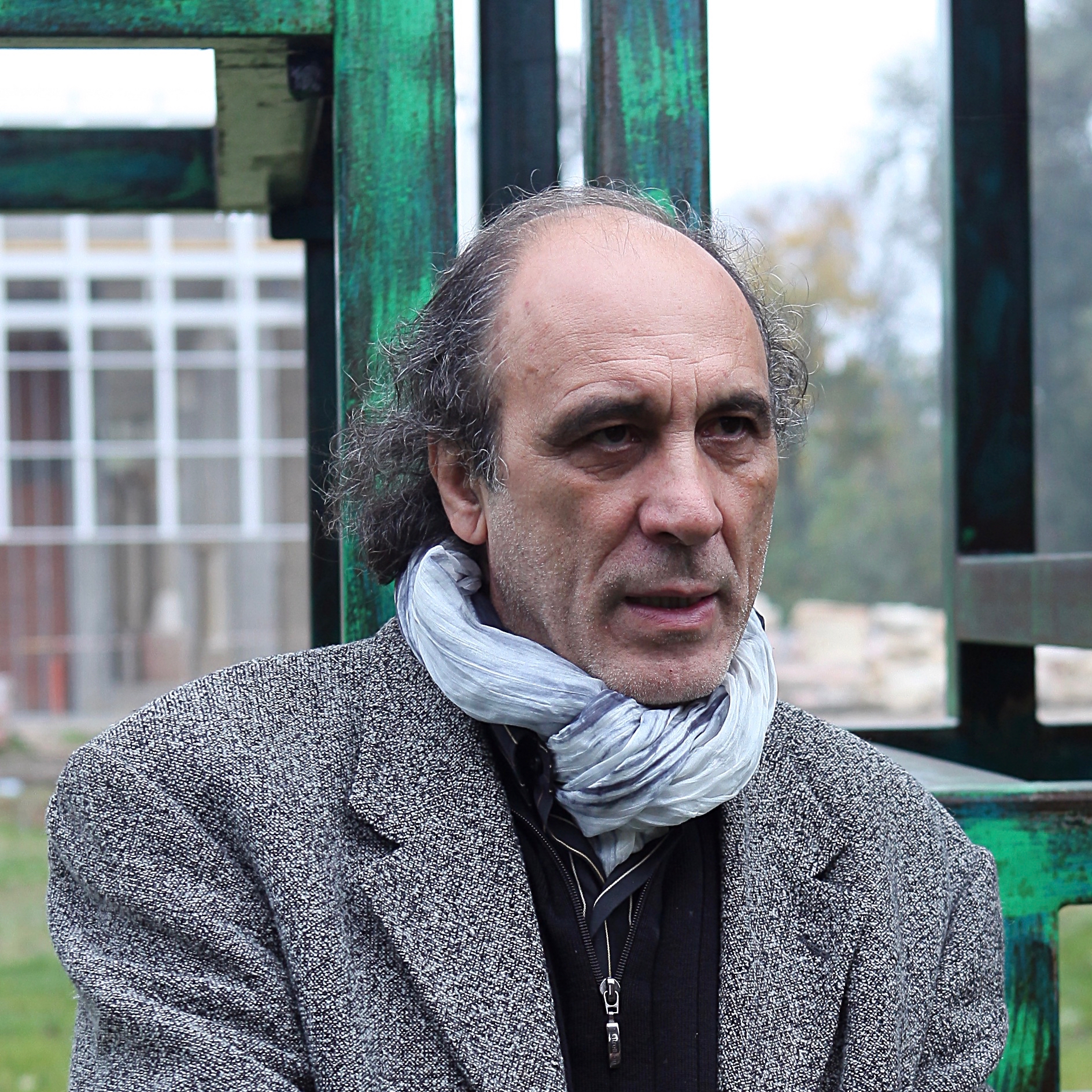
Stefan Râmniceanu was born in Ploiesti in Romania in 1954 and lives and works in Paris and Bucharest. An alumnus of the Nicolae Grigorescu Faculty of Fine Arts, from which he graduated in 1979, he is an emblematic figure in Romania’s contemporary art world. He has been a success with the public and critics alike from his earliest exhibitions onwards. He is one of those “artists who know how to captivate, irritate and surprise; in other words, he has the gift of being unpredictable,” as the philosopher and art historian Andrei Pleșu wrote.
Stefan Râmniceanu’s artistic career began in Romania in the 1980s. His first two solo exhibitions, at the Giulești Theatre (1979) and the Amfiteatru Gallery in Bucharest (1980), were followed by obtainment of a grant from the Romanian Visual Artists’ Union, award of the Amfiteatru Magazine Prize, and participation in various competitions and collective exhibitions. In 1985, he was invited to exhibit simultaneously at two of the Romanian capital’s top galleries: Atelier 35 and the Orizont Gallery. The event drew the attention of such leading cultural figures as the art critic and historian Radu Bogdan and the writer and philosopher Nicolae Steinhardt, both of whom dwelt on the way in which the painter had rethought light, while, for the historian Răzvan Theodorescu, his body of work was proof that Romanian art had a future. The years that followed saw the artist representing his country in increasing numbers of international collective exhibitions, in Hungary, Austria and Bulgaria, winning his first international award at the Painting Triennale in Sofia.
In 1988, Stefan Râmniceanu mounted the Ferecătura exhibition in Bucharest’s oldest princely palace. Intended to celebrate the 300th anniversary of Prince Constantin II Brâncoveanu of Wallachia’s ascension to the throne, the event hoped to reinvent the grammar of Orthodox Byzantine art, at a time when Nicolae Ceausescu’s 33-year-long communist dictatorship was starting to crumble. “Your art is a comforting response to the collapse of palaces, for you turn their ruins into a mighty sounding board for a nobility of spirit steeped in history and full of hope,” his teacher, the painter Ion Sălișteanu, wrote in October 1988. Years later, the art critic and Romania’s former Ambassador to UNESCO, Dan Hăulică, asserted, “It was truly a call to us all, a call to memory, a call for the courage to restore the past…”
With the 1988 exhibition, the artist’s name began to make the rounds in the western powers’ diplomatic circles, which opened the doors of the “free world” to his art. The Greek Minister of Culture suggested that he repeat Ferecătura in Athens under the name Report to Byzantium. Shortly after taking part in the Romanian Revolution in December 1989, Râmniceanu was invited by the French government and set up his studio in Paris (1991). He became a resident at the Cité Internationale des Arts and obtained French nationality (1999). Numerous exhibitions in galleries and institutions succeeded each other. In 2001, Arlette Sérullaz, Honorary General Curator at the Louvre’s Graphic Arts Department and former Director of the Delacroix Museum, wrote the preface to the first monograph devoted to Stefan Râmniceanu’s body of work, entitled Entre Orient et Occident, un alchimiste qui a traversé les âges (Between East and West, an alchemist who has crossed the ages).
In 2014, the artist once again celebrated the memory of Constantin II Brâncoveanu, three hundred years after his death. For his triumphant return to Romania, several institutions devoted a major retrospective to him, entitled Marks (Urme). Over 400 works, including 30 monumental sculptures were exhibited.
Râmniceanu’s work is included in many private and public collections, in Argentina, Brazil, Belgium, Bulgaria, Canada, France, Germany, Greece, Italy, Japan, Monaco, Morocco, the Netherlands, Portugal, Romania, , Spain, Sweden, Switzerland, Tunisia, Turkey, the United Kingdom, the United States and Venezuela.
